This is a quick introduction into argument maps: How to create them, how to read them and what you can expect to get out of it.
An Argunet argument map visualises the structure of complex argumentations and debates as a graphical network. In this network all nodes are either sentences or arguments and all relations between them are either attack or support relations.
The reconstruction and visualisation with argument maps can be useful in many ways:
- Argument maps can give you a fast overview over the state of a debate
- Argument maps help you to remember complex argumentation structures
- The logical reconstruction allows a detailed analysis and evaluation of arguments and dialectic strategies
- Argument maps help to keep focused on relevant parts of the debate by filtering out irrelevant or redundant information
- Argument maps help concentrate on a rational, fair debate
- Argument maps can guide and structure live discussions. Misunderstandings, repitition and unfair persuasion techniques can be avoided.
- Argument mapping can be used for presentations or whole seminars
How do I read an argument map?
Argument Maps contain two elements: Sentences and Arguments.
Sentences

Sentences are visualised as small framed white boxes.
Arguments

Arguments are visualised as small colored boxes
Reconstructed Arguments
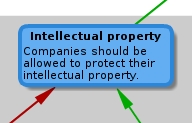
If an argument has been logically reconstructed, the argument is visualised as a small framed colored box. You can open the logical reconstruction by clicking on it.
Logically an argument consists of nothing else but sentences. But these sentences play different roles in an argument. Every argument has one inferred sentence (the conclusion) and at least one sentence from which the conclusion is inferred (a premiss). This premiss-conclusion structure is visualised as a sentence list: First all premisses of the argument are listed. Each horizontal line symbolizes an inference. Under the line the conclusion is listed (sometimes there are preliminary conclusions). Under the last line stands the main conclusion of the argument.
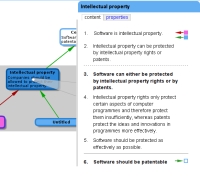
Support relations
If an argument supports a sentence of another argument, a green arrow is drawn from the former to the latter.
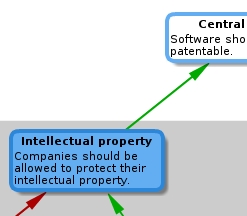
If the arrow is drawn-through, the support relation has been logically reconstructed. Logically, an argument supports another argument, if the conclusion of the supporting argument is equivalent to a premiss of the supported argument (”Socrates is mortal”, “Socrates will die”).
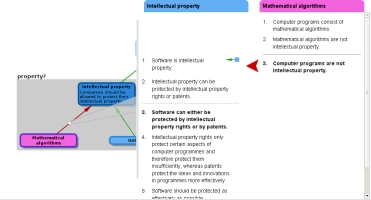
If you click on the arrow, you can see which sentences are defined as equivalent.
If the arrow is dashed, the support relation is only sketched and not logically reconstructed.
Attack relations
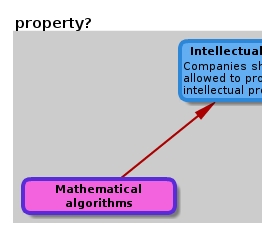
If an argument attacks a sentence of another argument, a red arrow is drawn from the former to the latter.
If the arrow is drawn-through, the attack relation has been logically reconstructed. Logically, an argument attacks another argument, if the conclusion of the supporting argument is contrary to a premiss of the supported argument (”Socrates is mortal”, “Socrates will never die”).
If you click on the arrow, you can see which sentences are defined as contrary.
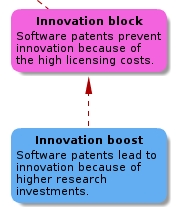
If the arrow is dashed, the support relation is only sketched and not logically reconstructed.
Reading tips
- Start from the center of the debate. Look for the central thesis (sometimes there are more than one). Open and read all reconstructed arguments that support or attack the central thesis. Proceed by going from the center to the periphery.
- An attack does not necessarily mean, that the attacked argument is a bad argument. A support does not necessarily mean the argument is good. It all depends on your evaluation: How plausible do you find the premisses of the attacking/supporting argument? Where are the weak points of the argumentation?
- Are the reconstructed arguments really valid? Does the conclusion follow from the premisses? If the argument is valid and the premisses are true, the conclusion has to be true, too. Is there a counter-example?
- Naturally, no argument map can contain every argument. The authors have always made a selection. Are there important arguments missing?
Please read the introduction of the Argunet Editor Help for further information.
Do argument maps tell me, what I should believe?
No, they don’t. Argument maps are just a tool you can use for making up your mind. The better an argument map is, the more unbiased and neutral it is.
Every argument presupposes premisses. How good the arguments in the argument map are depends on how plausible their premisses are. The attack and support relations of the argument map do not determine the plausibility of the premisses, they only limit the possibilities by relating the plausibilities of different sentences to one another.
So, it is really up to you. Argument maps can show you, which questions you have to answer to make up your mind. They can not answer these questions for you.
Just download Argunet Editor for free. Start Argunet and click on “Create a new debate”. You can create local debates on your computer or start an online debate to collaborate with others.
How can I create an argument map?
Follow the instructions in our first Tutorial (All tutorials come with your Argunet installation, so you do not have to read them online). It won’t take long and will teach you the Argunet basics.
Is there any difference to mind-mapping?
Yes, there are many differences. Argument maps may remind you of mind maps, because they look similar. But that’s about it. Mind maps have a different methodology, serve different purposes and are used by different people. Here are just some important differences:
- Mind maps are used for brainstorming, i.e. the collection of subjective associations, opinions, ideas of all sorts. Argument maps are used for the logical reconstruction and analysis of controverse debates. In most cases these debates will take place between different people with different perspective and not in your mind alone.
- In mind maps the visualisation means to you, what you want it to mean. That may be great for you, but it is not so great if you want to share the products of your mind with others. In every Argunet argument map the meaning of all elements always stays the same and is well defined by logic or argumentation theory. This precision is not only necessary if you want to assess complex arguments and argumentations. It gives you also the opportunity to share your insights with others in a common visual language.
- There are no real rules in mind-mapping. You can do what you want. Nobody can say what is right and what is wrong. In contrast, giving and taking reasons is a rule guided practice. There are rules about good and bad reasoning. Argument maps can not guarantee good reasoning. But they can restrict the users options in a way that makes it more probable. This rule-guided reconstruction makes it possible to collaborate on argument maps even if the participants have opposing views in the reconstructed debate.
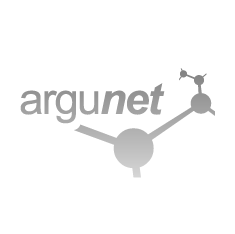
My PhD is related to domain ontologies and their construction process. As a shared conceptualization, they are discussed by stake holders. Capturing the ontology design rationale might be also approached as an argumentation process. Thus, your approach seems to converge with my investigation. Do you have the language meta-model? Or any material from which I can go further in studying the applicability of you work? Thanks.
Sorry for answering so late.
Thanks for your interest. You might want to check out http://philpapers.org/rec/BETAAV and other publications of us where we introduce the theory of dialectical structures.